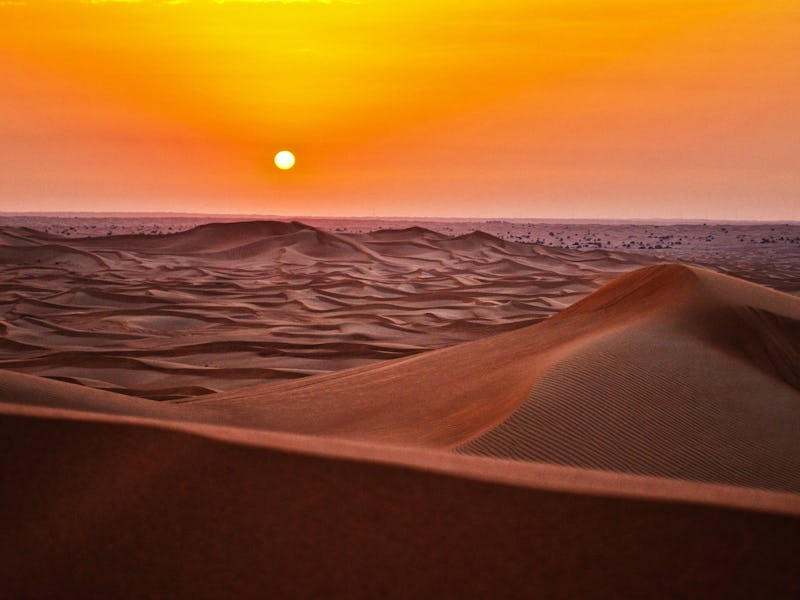Solar Energy: How a Small Patch of the Sahara Desert Could Power the World
It could solve the impending climate crisis.

Covering a patch of North Africa’s Sahara desert in solar panels could provide an abundance of clean renewable energy for the world, a new analysis argues. A vast sunlight-powered installation could help humanity meet its targets for reducing carbon emissions and avoiding a climate disaster, but it would face a number of real-world issues before getting off the ground.
This is according to Amin Al-Habaibeh, a professor at Nottingham Trent University that has researched the idea, writing in an article published on The Conversation Thursday. According to his estimates, if all the sunlight hitting the desert was converted into electricity, it would provide 7,000 times more power than Europe’s total energy demand.
“Just a small portion of the Sahara could produce as much energy as the entire continent of Africa does at present,” Al-Habaibeh said. “As solar technology improves, things will only get cheaper and more efficient. The Sahara may be inhospitable for most plants and animals, but it could bring sustainable energy to life across North Africa — and beyond.”
The idea has been floating around for a while, with experts pointing to estimations that suggest the whole world could run on Sahara energy by covering the equivalent of a small patch of land:
Covering the Sahara in Solar: Is It a Good Idea?
A giant solar project could offer benefits beyond electricity. Other images envision how developers could harness the desert’s abundance of sunlight to produce food alongside electricity:
This idea, known as “agrophotovoltaics,” has been touted in solar circles as a way of boosting land use efficiency by 60 percent. The above image, from the Sahara Forest Project, would cover 10 hectares in Tunisia and cost $30 million, and would use the solar energy to help cultivate the crops.
Al-Habaibeh suggests a larger project could use concentrated solar power, like the installation above. This would beam back sunlight to heat a container and power a steam turbine, storing up energy in the form of molten salt. A similar project has been proposed in the United Arab Emirates, and would avoid the struggles of placing photovoltaic panels under intense heat.
A larger project covering more land poses problems, though. For starters, the Sahara desert is governed by a number of countries and is home to a number of people. Olúfẹ́mi Táíwò, a professor at Georgetown University, said in the same story in The Conversation that it could amount to “climate colonialism.”
Covering the Sahara in Solar: Where Else Could We Cover?
Covering large swathes of land in solar is not a new idea, and many thinkers have proposed similar era-defining projects to stave off widespread climate catastrophe.
The Sahara plan bears similarities to an idea proposed by tech entrepreneur Elon Musk. In July 2017, he told a meeting of American state governors that the country could meet all its energy needs with a solar installation measuring 100 miles by 100 miles. A battery storage system, to enable 24-hour power delivery, would measure a further one mile by one mile.
A similar idea, proposed by Modern Survival Blog writer Ken Jorgustin, would cover a square measuring just 44 miles per side. This was based on the assumption that the United States’ annual energy consumption is 3.6 trillion kilowatt-hours, and that the project could use a Sharp ND-250QCS panel measuring 65 by 35 inches. It would require over three billion of these panels to meet the country’s energy needs, with each one providing 250 watts.
Jorgustin’s plan, assuming a cost of $250 per panel, would total around $767 billion, a fraction of the United States government’s $3.6 trillion expenditure in 2012 but an investment that could prove difficult to sell to the electorate. The total area sounds huge, but a satellite image mockup shows it would occupy a tiny red square.
Others have outlined more ambitious ideas. The below map by Parag Khanna envisions how the world may look after four degrees of warming. Far from covering the Shara in panels, it covers most of North Africa, the Arabian Peninsula, Spain, the United States and the Australian outback in solar-storing panels:
How the world may change under four degrees of warming.
Far from a fun thought experiment, ideas like Khanna’s could become a disturbing necessity.